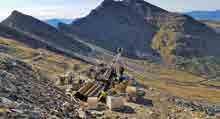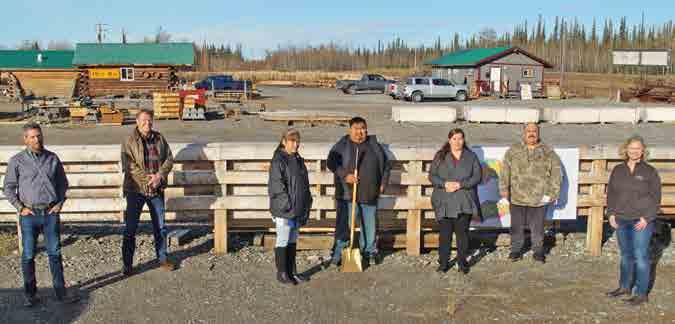
13 minute read
MINING
Mining Optimism
Several statewide mining projects bolster economic outlook
By Julie Stricker
In 2020, mining provided a bright spot in an otherwise bleak economy for Alaska.
While the COVID-19 pandemic decimated the tourist industry and pinched the oil and gas sector, mining stayed on track, with none of the six major operating mines reporting pandemic-related shutdowns. Several other mineral prospects also advanced and exploration efforts remained robust, with $127 million spent on exploration in 2020 alone, according to a report by McKinley Research Group that was commissioned by the Alaska Miners Association and the Council of Alaska Producers.
Another $430 million was spent on mine construction and capital investments. Alaska’s mines produce coal, gold, lead, silver and zinc, as well as construction materials such as sand, gravel, and rock.
Two projects are in the advanced permitting stages; several others are in the works in various stages of development.
Pebble
The Pebble project is a world-class copper and gold deposit in Southwest Alaska owned by Northern Dynasty through its wholly owned subsidiary Pebble Limited Partnership. It also contains significant amounts of silver, molybdenum, rhenium, and more, which would be accessed through an open pit mine. According to the project description, during its twenty years of production, the mine would produce an annual average of 318 million pounds of copper; 362,000 ounces of gold; 14 million pounds of molybdenum; and 1.8 million ounces of silver.
Despite the wealth of minerals at the site, Pebble has proved controversial due to its location near the headwaters of several streams that feed into salmon-rich Bristol Bay. The US Army Corps of Engineers published the final Environmental Impact Statement for the project in July 2020, noting it "would not be expected to have a measurable effect on fish numbers" in Bristol Bay.
However, the following month, the agency halted the permitting processing, saying that the project proposal contains too many environmental risks and "lacks adequate compensatory mitigation." It asked Pebble to come up with a detailed mitigation plan to offset environmental risks. However, in November, the Corps of Engineers denied a key permit saying it has "determined that the applicant's plan for the discharge of fill material does not comply with the Clean Water Act guidelines."
Colonel Damon Delarosa, commander of the Corps' Alaska District, says the agency determined that "the proposed project is contrary to the public interest." Pebble is appealing that decision and the denial of a key water permit, but for now, further development is on hold.
Donlin Gold
The Donlin Gold project is in the Yukon Kuskokwim region in southwest Alaska and holds one of the largest known undeveloped deposits of gold in the world, an estimated 33.8 million ounces. Donlin Gold is jointly owned by subsidiaries of NovaGold Resources and Barrick Gold Corporation.
In 2020, Donlin continued its drilling program to outline the deposit, which reports 2.24 grams per tonne overall, with some areas showing much higher grades. Mark Bristow, president and CEO of Barrick, says the assay results are encouraging. "The ongoing modeling work and planned 2021 follow-up drilling program could further enhance the project parameters,” Bristow says.



Mike Schrider, COO, Ucore Rare Metals
Trilogy Metals

Greg Lang, NOVAGOLD’s president and CEO, adds, “In an era characterized by declining gold grades, it is truly rewarding to continue to be able to report drill results that support the potential of Donlin Gold, already an impressive asset in terms of size and grade for a large-scale open-pit gold project. Indeed, the latest assay results continue to point to additional highgrade gold intersections that have only served to add confidence in recent geologic modeling concepts, while confirming multiple highgrade extensions in both the intrusive (igneous) and sedimentary rocks.”
In August 2020, Donlin reached a major permitting milestone when the Corps of Engineers and Bureau of Land Management issued a joint record of


INTEGRATED FACILITY
MANAGEMENT(IFM)
Denali Universal Services (a Sodexo company) is dedicated to providing safe, customizable, and efficient support to remote campsites. We provide the right people, the right equipment, and right resources to help maintain and operate your facility like no one else.
DENALIUNIVERSAL.COM | 907.263.6108

In unity, we accomplish great things.

Signing ceremony at Manh Choh in 2020. From left to right: Jeremy Brans, Fort Knox; Rick van Nieuwenhuyse, Contango ORE; Marianne Young, Tetlin Village Council; Chief Michael Sam; Kristie Charlie, Tribal Administrator; Vince Paul, Council Member; Anna Atchison, Fort Knox.
Kinross Gold
decision. It was the final step in the federal review of the proposed mine under the National Environmental Policy Act. It also received several key permits. Donlin Gold operators are looking at how to optimize the construction and startup of the mine, which they have said has the potential to produce an average of more than 1 million ounces of gold annually over a twenty-seven-year lifespan. It could create up to 1,000 jobs.
Livengood
The Livengood Gold Project is on the Elliott Highway, 70 miles north of Fairbanks in a region that has been home to placer mines for more than a century. The Livengood project, owned by International Tower Hill Mines, is estimated to have 11.5 million ounces of indicated gold resources at an average grade of 0.68 to 0.71 grams per tonne. The deposit is located on a ridge aptly named Money Knob.
A 2017 study showed that the project would break even at a gold price of $1,231 per ounce. Over the past decade, International Tower Hill Mines has conducted an extensive drilling program to outline the resource and engineering optimization studies to improve the economics of a potential mine. In 2021, its focus is to complete a prefeasibility study, which is expected in October, according to ITH Mines CEO Karl Hanneman.
“The gold market’s continued strength gives us strong motivation "Ucore is very appreciative of the efforts by the AIDEA board and staff as we pursue a potential co-development partnership which will greatly benefit the state of Alaska and contribute to criticalmetals independence for the United States.”
Mike Schrider, COO, Ucore Rare Metals
to advance our work to establish the best foundation to support future development,” Hanneman says. “The 11.5 million ounce gold resource at the Livengood Gold Project is in a premier jurisdiction and the large resource size gives our project high leverage to the gold price.”
The permitting process is expected to take another about four years and mine construction about two-and-a-half years, according to the company.
It is forecast to generate about 1,000 jobs during the construction phase and 350 while the mine is in operation, and workers would be bused to the site. Current mine life is estimated at twenty-three years. ITH also controls another 74 square miles of land in the immediate vicinity of the Money Knob deposit where additional gold mineralization has been found.
Upper Kobuk Mineral Projects
The Upper Kobuk Mineral Project is an advanced exploration project focused on two sites, Arctic and Bornite, near Ambler in Northwest Alaska. The sites contain rich deposits of copper, zinc, gold, silver, lead, and cobalt and are being developed by Ambler Metals, a 50/50 joint venture between South 32 Limited and Trilogy Metals. It is one of the largest undeveloped copper-zinc mineral belts in the world, but development has been hampered by the lack of transportation infrastructure.
The company plans to spend $27 million in 2021 on a drilling program and further exploration around the Arctic site with an eye toward beginning the permit process late in the year. In 2020, it received the final
Environmental Impact Statement Joint Record of Decision and a wetlands permit for a 211-mile access road that will connect with the Dalton Highway.
The Ambler Road has proven to be a contentious topic, with a tribal consortium and five Alaska Native tribal governments having filed a lawsuit to stop it, saying the federal review of the road's impact was "rushed, flawed, premature, and inadequate." The road itself is expected to cost at least a half billion dollars to construct. In February, Ambler Metals entered into an agreement with the Alaska Industrial Development and Export Authority (AIDEA)—the state's investment arm— to evenly split $70 million in predevelopment work on the road.
“We value the relationship that we’ve established with AIDEA and this agreement will further advance our partnership to develop the long-term potential for the Ambler Mining District,” says Ramzi Fawaz, president and CEO of Ambler Metals.

Graphite Creek
The Graphite Creek project on the Seward Peninsula about 37 miles north of Nome is the largest known, and highest grade, large flake graphite deposit in the United States. It is wholly owned by Graphite One (Alaska), which plans to build a vertically integrated business to mine, process, and manufacture the highgrade graphite, primarily to make lithium-ion batteries for electric vehicles. Currently, the United States imports graphite from China.
Graphite One estimates the deposit is large enough to feed the project for forty years at a rate of about 55,350 tonnes annually. Graphite has been mined at the site on a small scale for a century.
In January, the federal government determined that the project qualifies as a High Priority Infrastructure Project, which gives Graphite One access to a more efficient federal permitting process. The company plans to complete its pre-feasibility study in mid-2021.

COMMITTED TO SERVING ALASKA FOR OVER 70 YEARS
OLES.COM
We all have a job to do to keep Alaska’s economy strong. Our clients are the ones improving state transportation infrastructure, expanding military facilities and building new commercial and residential buildings. As a law fi rm, our job is simple – help our clients fi nd solutions to legal issues that arise at all stages of the construction process so the job can get done and our state can thrive.
ALASKA I WASHINGTON I CALIFORNIA
WE BELIEVE IN ALASKA.
We’re proud that our mine in Southeast has statewide impact, supporting jobs far beyond Juneau, paying millions in state and local taxes, supporting a long list of local nonprofits and buying goods and services from dozens of Alaska companies. That’s Miner Strong.
Manh Choh
A gold deposit near the village of Tetlin off the Alaska Highway in eastern Alaska is in its scoping phase. Formerly www.akbizmag.com

“The gold market’s continued strength gives us strong motivation to advance our work to establish the best foundation to support future development. The 11.5 million ounce gold resource at the Livengood Gold Project is in a premier jurisdiction and the large resource size gives our project high leverage to the gold price.”
Karl Hanneman, CEO, International Tower Hill Mines
called Peak Gold, Kinross Alaska acquired a 70 percent interest in the site in September 2020. In February, Kinross announced the site has been renamed "Manh Choh," which was chosen by Village of Tetlin Chief Michael Sam and the tribal council. Manh Choh means Big Lake in the Upper Tanana Athabascan language, a reference to nearby Tetlin Lake.
Kinross, which operates the Fort Knox gold mine about 250 miles northwest of Manh Choh, plans to build an open pit mine at the site and truck the ore to its existing mill and processing infrastructure. The site contains approximately 1 million ounces of relatively high-grade gold, about 6 grams per tonne. The project is in the preliminary economic assessment stage. Kinross expects to complete permitting and a feasibility study by the end of 2022. Production is expected to begin in 2024 and continue for about four years, although there is the potential for additional gold discoveries in the area. "Blending higher grade ore from the Peak Gold project with Fort Knox ore is expected to extend mill operation at Fort Knox, reduce overall costs, and increase cash flow," according to Kinross.
Niblack Project
After a several-year hiatus, work resumed in 2020 at the Niblack Project in Southeast Alaska. Niblack is a high-grade copper, zinc, gold, and silver prospect about 30 miles southwest of Ketchikan.
Heatherdale Resources has a 100 percent interest in Niblack. The
wise counsel
DORSEY ATTORNEYS HAVE SERVED AS TRUSTED COUNSEL TO ALASKA CLIENTS FOR OVER 20 YEARS
With over two decades of history in the Anchorage community, Dorsey & Whitney provides full-service legal counsel to clients in the Alaska market and beyond. Backed up by the resources of an international law firm with over 550 attorneys across 19 offices, we offer global reach, local resources, and productive relationships. All with a deep understanding of our clients’ businesses, the risks they face, and the goals that drive them. Making us a wise choice for smart businesses everywhere.
TOP RANKED
LAW FIRM IN ALASKA
12 PRACTICE AREAS
Corporate Law, Commercial Litigation, Real Estate, Employment Law, and others U.S. News–Best Lawyers 2021 (Woodward White, Inc.)
company reorganized in 2020 with the appointment of Robert McLeod as president and CEO, and work at Niblack resumed. Niblack was first mined in the early 1900s as an underground mine and the site consists of an underground tunnel and several major deposits. Niblack is located at tidewater and ore could be barged to a central processing facility at low cost.
In 2020, Heatherdale undertook a drilling program to further outline the deposit, with promising results. Additional drilling is planned for this year, underground at the Lookout zone and on the surface at the highgrade Dama Cu zone, according to the company. "We are exceptionally encouraged with our first round of drilling, targeting some of the highest-grade massive-sulfide mineralization that has been recognized on the property," McLeod says.
The 2020 work showed that the deposit extends in a different direction than what was previously thought. "This confirmation has significantly increased the exploration potential Palmer Project
The Palmer Project is a copper, zinc, silver, gold, and barite prospect about 35 miles southeast of Haines. The advanced exploration project is operated by Constantine North under a joint partnership between Constantine (51 percent) and Dowa Metals & Mining (49 percent). Development is primarily underground and not far from historic placer mines. The mineralization at Palmer occurs in the same belt of rocks as the Greens Creek mine, the company says.
A preliminary economic assessment was completed in June 2019 and shows a mine life of about eleven years.
Bokan-Dotson Ridge
The Bokan-Dotson Ridge Rare Earth Mine on the southern tip of Prince of Wales Island hosts highgrade rare earth elements, such as dysprosium, terbium, and yttrium, which are used in high-tech products. It is an advanced exploration project under development by Ucore Rare Metals. In 2019, its mineral resources were upgraded with an additional 38.5 thousand tonnes of critical and strategic metals, including niobium, zirconium, beryllium, hafnium, titanium, and vanadium.
Currently, the United States must import rare earth elements from China. "Not only are these ancillary metals valuable augmenting components of the Bokan Resource, they're among a select group of metals now earmarked by the US government as critically required by domestic growth industries," says Mike Schrider, Ucore COO.
The company is talking with AIDEA about its plans to build a separation and processing plant in Ketchikan operated under wholly owned subsidiary Alaska SMC. "Ucore is very appreciative of the efforts by the AIDEA board and staff as we pursue a potential codevelopment partnership which will greatly benefit the state of Alaska and contribute to critical-metals independence for the United States," Schrider says.
RELIABLE ENERGY IS ESSENTIAL
You have many things to worry about, but reliable energy shouldn’t be one of them. Usibelli Coal Mine is committed to supplying our customers with reliable energy, while continuing to protect the health and safety of our workers. Count on us being there to provide the affordable energy you need. We’ve been doing it everyday for the last 77 years.










